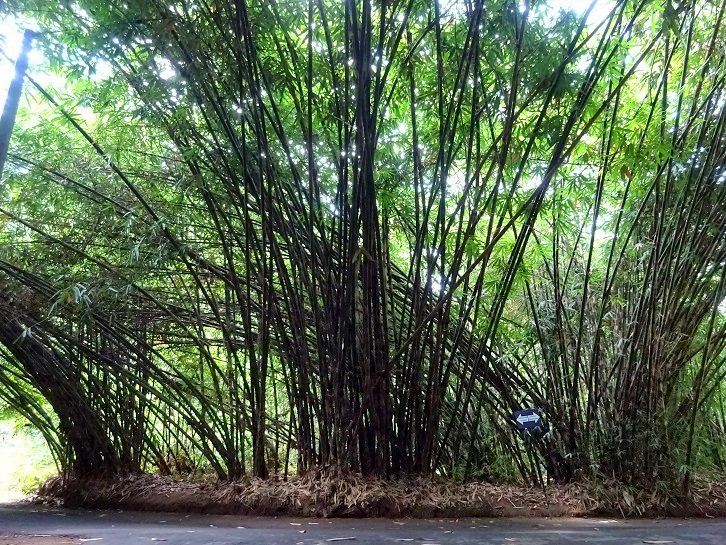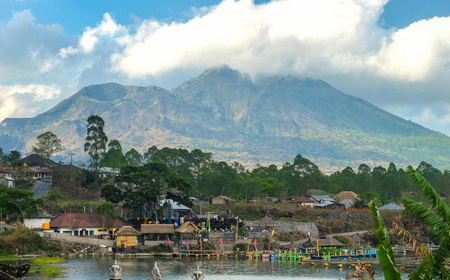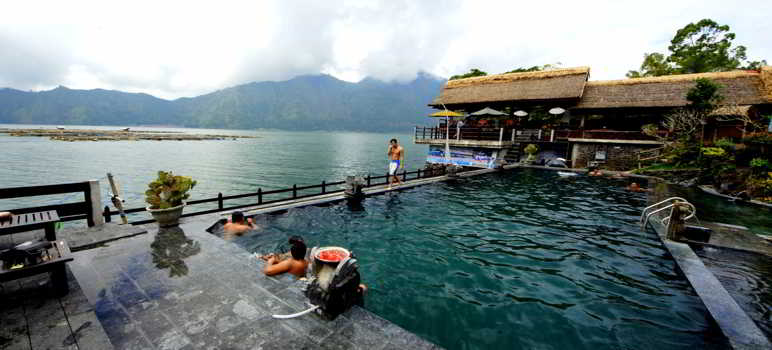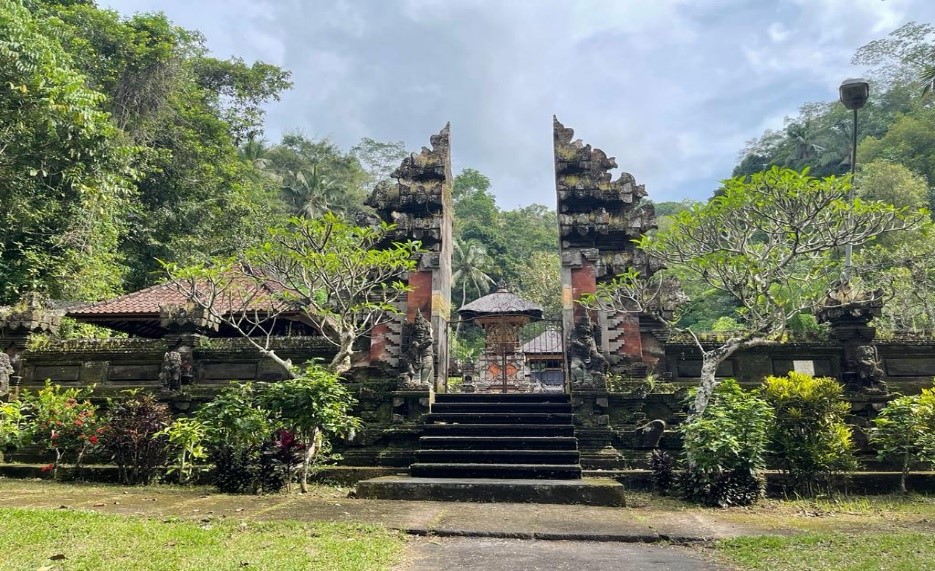bangli

Welcome to Bangli Regency, Bali's hidden gem! Steeped in rich history and surrounded by breathtaking natural wonders, this enchanting destination promises an unforgettable experience for every traveler.
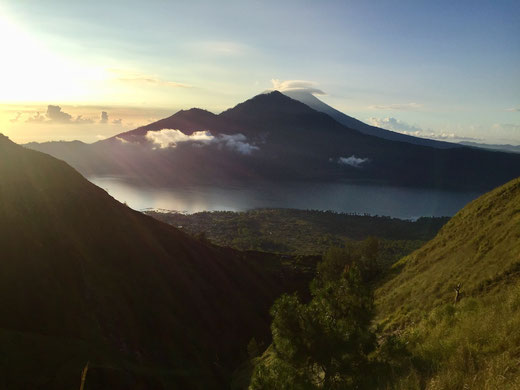
Dating back to ancient times, Bangli has a storied past as one of Bali's oldest kingdoms. Its historical significance is evident in the well-preserved temples and cultural heritage that dot the landscape. Delve into the region's captivating history as you explore the majestic Pura Kehen, a stunning 11th-century Hindu temple.
For nature enthusiasts, Bangli boasts a diverse range of attractions. Marvel at the awe-inspiring Mount Batur, an active volcano that offers mesmerizing sunrise trekking opportunities. Discover the serene beauty of Danau Batur, a volcanic lake surrounded by lush forests and charming villages.
Experience the warm hospitality of the locals and savor authentic Balinese cuisine at the traditional markets. Unwind in the soothing hot springs of Toya Bungkah, renowned for their therapeutic properties.
With its historical allure and awe-inspiring landscapes, Bangli Regency is a must-visit destination for travelers seeking an immersive and culturally enriching Balinese experience. Embrace the charm of this untouched paradise and create memories to last a lifetime.
History
Centuries ago, Bangli Regency played a crucial role in Bali's historical landscape due to the presence of Lake Batur, a significant water source for the irrigation of South and East Bali. This invaluable water supply made the region highly coveted, leading to intense conflicts and power struggles among neighboring rulers.
Amidst these disputes, Bangli emerged as a pivotal player and eventually became the capital of a prominent Balinese kingdom. In the Balinese calendar, this significant milestone was marked in the year 1204, known as the Balinese Icaka year. This marked a turning point in Bangli's history, solidifying its position as a center of power and governance in the region.
As the kingdom's capital, Bangli grew in prominence, attracting artisans, scholars, and religious leaders who contributed to the flourishing cultural and artistic heritage of the area. Temples, palaces, and other architectural wonders were constructed, reflecting the kingdom's prosperity and deep-rooted spirituality.
Today, the historical significance of Bangli is still evident in its ancient temples, traditional customs, and the profound reverence of its people for their heritage. Travelers to this regency can immerse themselves in the fascinating stories of the past while exploring the scenic landscapes and vibrant culture that continue to thrive in this captivating part of Bali.
aga communities
The Aga communities in the Bangli area of Bali are unique and distinct cultural groups known for preserving their ancient traditions and way of life. The term "Aga" means "original" or "ancient," and these communities are considered the indigenous people of Bali, predating the arrival of the Hindu Majapahit dynasty in the 14th century.
Here are some key aspects of the Aga communities in the Bangli area:
Cultural Heritage: The Aga people have preserved their pre-Hindu traditions and practices, setting them apart from the rest of the Balinese population. Their customs, rituals, and social structure have remained largely unchanged for centuries.
Architecture: The Aga villages feature unique and ancient architectural styles. Their houses are typically made of stone and have thatched roofs, providing a glimpse into traditional construction methods.
Religion and Beliefs: The Aga communities practice a form of animism and ancestor worship, which predate the introduction of Hinduism to Bali. They have their own religious rituals and ceremonies, which have been handed down through generations.
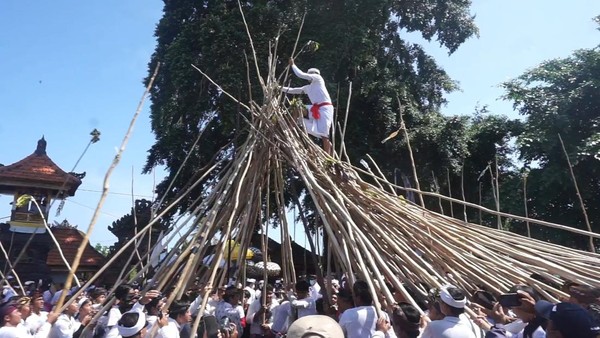
Subak System: Like other Balinese communities, the Aga people also practice rice cultivation using the subak system, which is an ancient irrigation method for rice terraces. This system is an integral part of their agricultural practices and sustains their livelihoods.
Language: The Aga communities have their own unique language, which is different from the Balinese language spoken by the majority of the island's population.
Tourism: In recent years, the Aga communities have seen an increase in tourism, with visitors interested in experiencing their traditional way of life and culture. However, it's essential for tourists to respect their customs and traditions and seek permission before exploring their villages.
While the Aga communities offer a glimpse into Bali's ancient past and cultural diversity, it's essential to approach them with sensitivity and respect, as they are not a tourist attraction but living communities with their own beliefs and practices. Visitors should seek guidance from local authorities or reputable tour operators to ensure they have a meaningful and respectful experience while visiting these unique communities in the Bangli area.
Bangli City
Nestled amidst lush landscapes and steeped in history, this enchanting city offers a unique and immersive travel experience. Explore the bustling Bangli Market, a vibrant hub where locals and visitors converge to discover a treasure trove of traditional handicrafts, aromatic spices, and fresh produce. Lose yourself in the kaleidoscope of colors and scents, and haggle for authentic Balinese souvenirs to take home.
Beyond the market's lively atmosphere, Bangli City boasts ancient temples like Pura Kehen, showcasing intricate carvings and captivating legends. Stroll through picturesque rice terraces and marvel at the majestic Mount Batur, an active volcano that provides breathtaking panoramas.
Whether you're a culture enthusiast, an adventure seeker, or a food lover, Bangli City is a must-visit destination, offering an unforgettable blend of history, nature, and authentic Balinese experiences.
bukit bangli
Bukit Bangli: This scenic hilltop area provides panoramic views of the surrounding landscapes and villages. It's an ideal spot for sunrise or sunset watching and offers a different perspective of the region.
pura kehen

Pura Kehen, a majestic jewel among Bali's ancient temples! With a rich history dating back centuries, this sacred site holds a profound significance in Balinese culture. Nestled in the heart of Bangli Regency, Pura Kehen exudes a mystical allure, drawing travelers and devotees alike.
Constructed in the 11th century, the temple's architecture showcases intricate stone carvings and unique pagodas, reflecting a blend of Hindu and indigenous Balinese design. Legend has it that the temple was a sanctuary for the divine, offering protection to the region during turbulent times.
Throughout the year, Pura Kehen hosts a myriad of captivating cultural events. Witness vibrant processions, mesmerizing dance performances, and elaborate ceremonies that celebrate the island's rich heritage and spiritual traditions.
Among the most enchanting events is the Galungan festival, when the temple comes alive with colorful decorations and offerings.
Bamboo Forest nr.Kubu
Bamboo Forest Nr. Kubu in Bali, a mere 5 kilometers away from Bangli! This natural wonder boasts an impressive array of bamboo species, including Petung and Bambu Talang, creating a captivating tapestry of greenery. As you stroll through this enchanting forest, you'll be mesmerized by the soothing sound of the wind whistling through the bamboo, a truly unique and tranquil experience. Embrace an eco-friendly escape and explore the winding paths that lead you deep into the heart of this mystical oasis.
Mount Batur
Experience the awe-inspiring allure of Mount Batur in Bali, standing tall at 1750 meters high. As a semi-dormant volcano, the last eruption was recorded in 1926, leaving behind a mesmerizing caldera, considered among the world's largest and most magnificent. A caldera is a unique volcano with a serene lake nestled at its center, and Mount Batur's Caldera is nothing short of breathtaking.
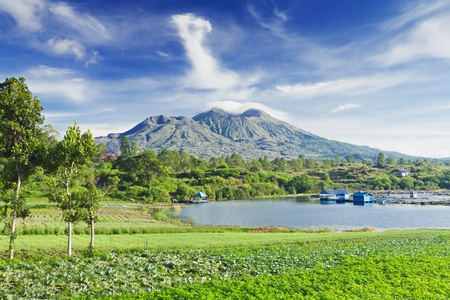
Embark on an exhilarating trek to the summit, where panoramic vistas of Bali's stunning landscapes unfold before your eyes. Feel the thrill of being close to a semi-active volcano, as wisps of smoke occasionally emerge from its crater, creating an otherworldly ambiance. At the base of the mountain lies Lake Batur, a vital water source for irrigation in South and East Bali, sustaining the island's flourishing agriculture.
Discover the captivating history of Mount Batur as you learn about the original village buried by lava during the 1927 eruption. The villagers' remarkable escape, saving sacred temple icons and cherished belongings, showcases the profound cultural and spiritual significance this mountain holds. Today, you can visit the transplanted temple, Pura Ulun Danu, perched high on the ridge, a testament to their enduring resilience.
Immerse yourself in the natural and cultural wonders of Mount Batur, as you marvel at the miracles of Bali's geological past and the harmonious coexistence of nature and spirituality. Capture cherished memories of this breathtaking destination, as you explore the beauty and tranquility that only Mount Batur can offer.
trunyan
Immerse yourself in the mystical allure of Trunyan Village, a unique and culturally rich destination in Bali that will transport you back in time. Located on the eastern shore of Lake Batur, Trunyan Village boasts ancient traditions and an exceptional open-air temple that beckons the curious traveler.
As you venture into this off-the-beaten-path village, you'll be captivated by the distinct customs and rituals that have been preserved for generations. The Trunyanese people have a fascinating belief system surrounding death, and their traditional cemetery, unlike any other in Bali, is an intriguing sight to behold. Known as "The Cemetery of the Temporary Corpse," it eschews cremation and burial and instead places the deceased out in the open, protected by the sacred Taru Menyan tree, which emits a surprisingly pleasant fragrance, offsetting any odor.

At the heart of the village stands the illustrious Trunyan Temple, a historical marvel that showcases intricate carvings and awe-inspiring architecture. This ancient place of worship holds immense spiritual significance for the locals and is a testament to their devotion to their ancestors.
The surrounding natural beauty of Trunyan Village is equally captivating. Nestled between the serene Lake Batur and the majestic Mount Abang, the village offers a breathtaking panorama that will leave you in awe. As you explore the village, you'll find yourself surrounded by lush greenery, pristine landscapes, and the soothing sounds of nature.
To fully experience the authenticity of Trunyan Village, consider participating in one of their traditional ceremonies, which are deeply rooted in Balinese culture and offer a glimpse into the spiritual essence of the community.
Embark on a cultural odyssey to Trunyan Village and its captivating temple, where the past and present seamlessly intertwine, offering an unforgettable experience that will enrich your understanding of Bali's rich heritage. Unveil the secrets of this extraordinary village, hidden away from the mainstream tourism, and create memories that will linger in your heart forever.
Penglipuran
Penglipuran is a traditional village located in the Bangli Regency of Bali, Indonesia. It is renowned for its well-preserved Balinese architecture, customs, and traditions. The village is situated about 45 kilometers northeast of Denpasar, the capital of Bali, and it attracts both local and international tourists who want to experience the authentic and cultural aspects of Bali.
Key features of Penglipuran village include:
Architecture: One of the main attractions of Penglipuran is its traditional Balinese architecture. The village is known for its neatly arranged rows of traditional houses made from bamboo, wood, and bricks. The architecture reflects the harmony between the residents and their environment.

Culture and Tradition: Penglipuran preserves the Balinese customs and traditions, and the village residents actively participate in various cultural activities. Visitors can witness traditional ceremonies, dances, and rituals, which provide an insight into the local way of life.
Cleanliness and Orderliness: Penglipuran is celebrated for its cleanliness and strict adherence to local customs. The villagers have a strong sense of community responsibility and maintain their environment meticulously.
Bamboo Forest: There is a beautiful bamboo forest near Penglipuran that visitors often explore. It offers a serene and picturesque environment for those who appreciate nature.
Tourism: Due to its unique cultural significance and picturesque settings, Penglipuran has become a popular tourist destination in Bali. Many visitors come to witness the authentic Balinese village lifestyle and the captivating scenery.
When visiting Penglipuran, it's essential to respect the local culture and customs. Modesty in attire and behavior is appreciated, particularly when entering temples or participating in ceremonies.
DUSUN KUNING WATERFALL
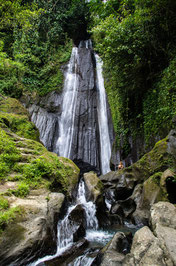
Discover the captivating beauty of Dusun Kuning Waterfall in Bangli Regency, Bali. Nestled in the serenity of Taman Bali Village, this hidden gem awaits those seeking an untouched natural wonder.
Only 3 kilometers away from Bangli town, the journey to Dusun Kuning Waterfall is a delightful adventure. Trekking approximately 300 meters through the picturesque landscape, you'll be immersed in the freshness of the surroundings.
Named after its location in the hamlet of Yellow, Bali Garden Village, District Bangli, this enchanting waterfall cascades gracefully 20 meters above the flowing Tukad river, adding to the allure of the area.
Dusun Kuning Waterfall showcases the pristine beauty of Bali's purest natures and offers an atmosphere of tranquility, far from the bustling tourist spots. Embrace the calming ambiance, and witness nature's brilliance as you stand in awe of this mesmerizing heritage.
Pengotan Village
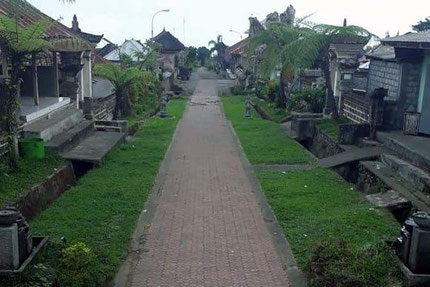
Experience the allure of Pengotan village, a captivating gem within Bangli regency. Steeped in rich history, this traditional pre-Majapahit village stands apart with its unique customs and vibrant traits.
At Pura Penataran, immerse yourself in the mesmerizing spectacle of diverse dancers during temple festivals. Witness the extraordinary Papah war and various Baris dances, celebrating their distinctive cultural heritage.
Even in solemn moments, Pengotan sets itself apart as their burial customs diverge from other Balinese Villages.
Unveil the enigmatic allure of Pengotan village, where authenticity and tradition intertwine, promising a one-of-a-kind journey into Bali's cultural tapestry.
tibumana waterfall

Tibumana Waterfall, a hidden treasure nestled in the heart of Bangli regency.
Surrounded by lush greenery, this enchanting cascade offers a serene escape for adventurers. Take a refreshing dip in the crystal-clear waters, and let the soothing sound of cascading water rejuvenate your senses.
Capture picture-perfect moments amid the picturesque landscapes and Instagram-worthy backdrops.
A haven for nature enthusiasts and photographers alike, Tibumana Waterfall promises an unforgettable experience in Bali's pristine wilderness.
Embark on a journey to this mesmerizing oasis, where tranquility and awe-inspiring scenery await your arrival.
Pura Dalem Balingkang
Pinggan Village (located in the Northern part of Lake Batur) originally built as a palace, this unique temple has a delightful mix of Balinese and Chinese influences, situated in a picturesque mountain scenery.
Puncak Penulisan Temple
Puncak Penulisan Temple, an ancient marvel dating back to the 9th century, is nestled in the serene Bangli regency of Bali. This historical Hindu temple holds immense cultural significance, as it is one of the oldest and highest temples on the island. Perched atop Mount Penulisan, the temple offers visitors a breathtaking panoramic view of Bali's lush landscapes, captivating sunrise, and neighboring peaks.
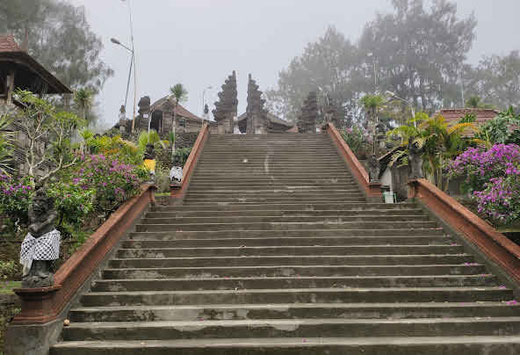
Stepping into Puncak Penulisan, you'll be transported through time by its well-preserved architectural wonders, intricate stone carvings, and sacred relics. Devotees and history enthusiasts alike are drawn to this spiritual sanctuary, where ancient rituals and ceremonies continue to be performed.
For those seeking a unique cultural experience and a glimpse into Bali's rich heritage, Puncak Penulisan Temple promises an unforgettable journey into the island's past and its enduring spiritual legacy.
The Puncak Penulisan Temple is composed of five different temple complexes. Each of these complexes has its own unique features and significance. They are located on different terraces of Mount Penulisan, creating a tiered structure as you ascend the mountain.
The five temple complexes are typically referred to as follows:
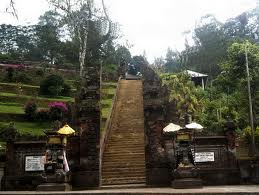
- Pura Tegeh Koripan: The lowermost complex, situated at the base of the mountain.
- Pura Panarajon: The second complex, located above Pura Tegeh Koripan.
- Pura Taman Pulasari: The third complex, situated above Pura Panarajon.
- Pura Daha Tua: The fourth complex, found above Pura Taman Pulasari.
- Pura Pancoran Senja: The highest complex, positioned at the peak of Mount Penulisan.
Each of these temple complexes holds its own spiritual significance and adds to the overall cultural and historical value of the Puncak Penulisan Temple. Visitors can explore these different levels, witness the unique architectural features, and enjoy the stunning views from various vantage points as they make their way to the topmost complex.
Pura Ulun Danu Batur
Pura Ulun Danu Batur, also known as Ulun Danu Batur Temple, is a significant Hindu temple located on the western shore of Lake Batur, in the Kintamani district of Bali, Indonesia. Here are some key details about the temple:
Spiritual Importance: Pura Ulun Danu Batur is dedicated to the goddess Dewi Danu, who is considered the goddess of the lake and rivers in Balinese Hindu belief. Balinese people pay homage to Dewi Danu for water irrigation, as Lake Batur is the main source of irrigation for the surrounding rice fields.
Location: The temple is situated at the foot of Mount Batur, an active volcano known for its stunning caldera lake. The picturesque location of the temple makes it a popular tourist attraction.
History: The original Pura Ulun Danu Batur was constructed in the 11th century but was later destroyed by a volcanic eruption. The temple was rebuilt in 1926 on a higher ground location to escape the lava flow from the eruption.
Architecture: The temple's design reflects traditional Balinese architecture. It consists of several shrines, including meru towers, pagodas, and pavilions, all adorned with intricate carvings and colorful decorations.
Religious Ceremonies: Pura Ulun Danu Batur plays a significant role in various religious ceremonies and rituals. The Balinese people regularly visit the temple to pay their respects and participate in religious events.
Ulun Danu Batur Festival: The temple hosts an annual festival known as the "Ulun Danu Batur Festival." During this event, elaborate ceremonies and processions take place to honor Dewi Danu and seek blessings for a successful harvest and water supply.
toyah bungkah
Toyah Bungkah is situated on the shores of Lake Batur, which lies at the base of Mount Batur, an active volcano. The village is well-known for its stunning views of the lake and the surrounding volcanic landscapes, making it a popular destination for tourists seeking natural beauty and outdoor activities.
Key features and attractions of Toyah Bungkah and its surroundings:
Lake Batur: As mentioned earlier, Lake Batur is the largest lake in Bali and provides a picturesque setting for the village of Toyah Bungkah. The lake's calm waters and the reflection of Mount Batur create a captivating scene that draws visitors from all over.
Mount Batur: Rising above Toyah Bungkah and Lake Batur is Mount Batur, an active volcano that attracts adventure enthusiasts. Hiking to the summit to witness the sunrise is a popular activity, and many tourists visit the village to start their trek to the top.
Hot Springs: Toyah Bungkah is home to natural hot springs, which are believed to have therapeutic properties. Tourists often visit these hot springs to relax and rejuvenate after hiking or exploring the area.
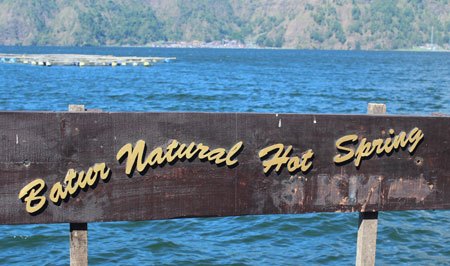
Traditional Villages: The village of Toyah Bungkah itself and nearby villages offer visitors a chance to experience traditional Balinese culture and architecture. The locals often engage in traditional activities and ceremonies, providing insight into the island's rich cultural heritage.
Outdoor Activities: Apart from hiking Mount Batur, the area around Toyah Bungkah offers opportunities for other outdoor activities such as cycling, fishing, and exploring nearby rice terraces.
Tourism Infrastructure: Due to its popularity among tourists, Toyah Bungkah has developed tourism infrastructure, including hotels, guesthouses, restaurants, and tour operators that cater to the needs of visitors.
Pura Tegeh Koripan
There is an ancient hilltop sanctuary, Pura Tegeh Koripan, several kilometers past Kintamani on a winding road, thought to have once belonged to the Pejeng Kingdom. This is actually a series of temples, scattered at different levels on a steep stone staircase that often disappears into the swirling mountain mists, where a number of different village clans come to worship. At the upper level is a bare courtyard with a number of simple shelters containing ancient statues of Balinese Rayas, divinities and lingga stones. These statues have been traced back to a number of different periods, ranging between the 11th and 15th centuries.
Sasana Budaya
Sasana Budaya is a cultural center that promotes and preserves the arts and culture of the region. "Sasana" translates to "hall" or "center," while "Budaya" means "culture" in Indonesian.
Cultural centers like Sasana Budaya are essential institutions that play a crucial role in preserving and promoting traditional arts, dance, music, and various cultural performances. They often serve as venues for cultural events, exhibitions, workshops, and other activities related to local arts and traditions.
Bukit Demulih
As the road climbs northwards out of Bangli a little hill comes into view, known as Bukit Damulih. This is well worth climbing, as it has a picturesque little temple at the top with a stunning view over central Bali. ¨Damulih¨ means don´t go home, so be careful not to fall under magic spell of this place.
Kintamani
Kintamani is a picturesque region located in the Bangli Regency of Bali, Indonesia. It is renowned for its stunning volcanic landscapes, including Mount Batur and Lake Batur. The area is a popular tourist destination due to its natural beauty, cool climate, and opportunities for outdoor activities.
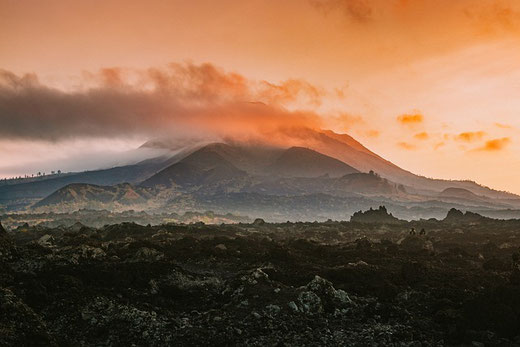
During the colonial era, the Dutch East Indies (now Indonesia) had various transportation and hospitality infrastructure for European travelers and officials. Rest houses and lodges were established at strategic locations to provide comfort and accommodation during long journeys.
Kintamani's highland location with its scenic beauty and cool climate might have made it an attractive stopover point for travelers. The K.P.M. Dutch Steamship Line, which operated in the Dutch East Indies, likely saw the potential of the location and took over the rest house to facilitate travel between the northern port of Buleleng and the southern parts of Bali.
Over time, the rest house might have fallen into disuse, leading to its current state of being rather dilapidated. Historic structures like these hold cultural significance and offer a glimpse into the colonial past of the region.
Kintamani Organic Farm: For those interested in organic farming and sustainable agriculture, a visit to a Kintamani organic farm is a great choice. Here, visitors can learn about traditional Balinese farming methods and participate in various farming activities.
comments
This list is for sure not complete. We welcome your comments and encourage you to share additional touristic, cultural, or historical facts about this regency. Your insights will benefit other readers visiting this page.

